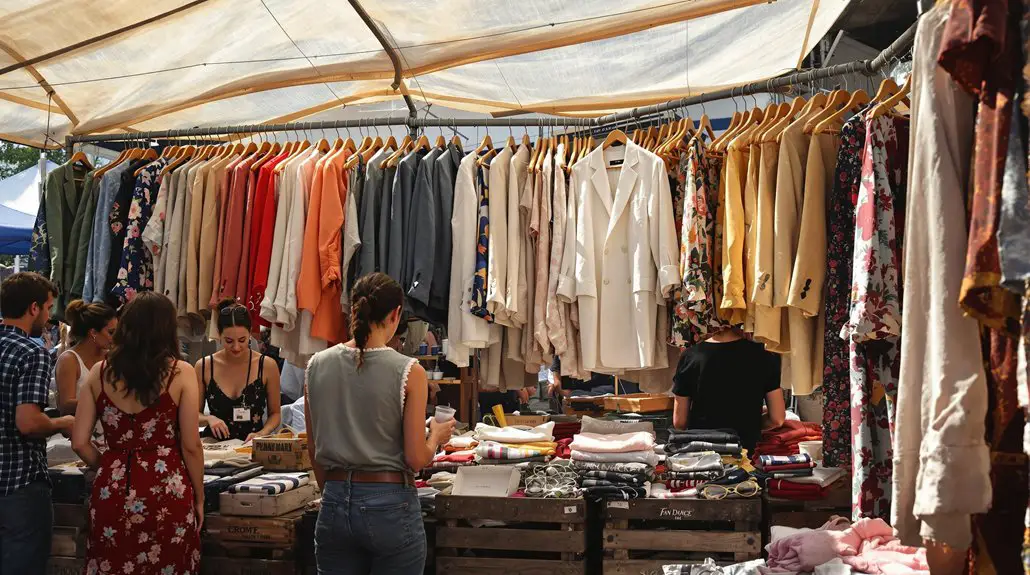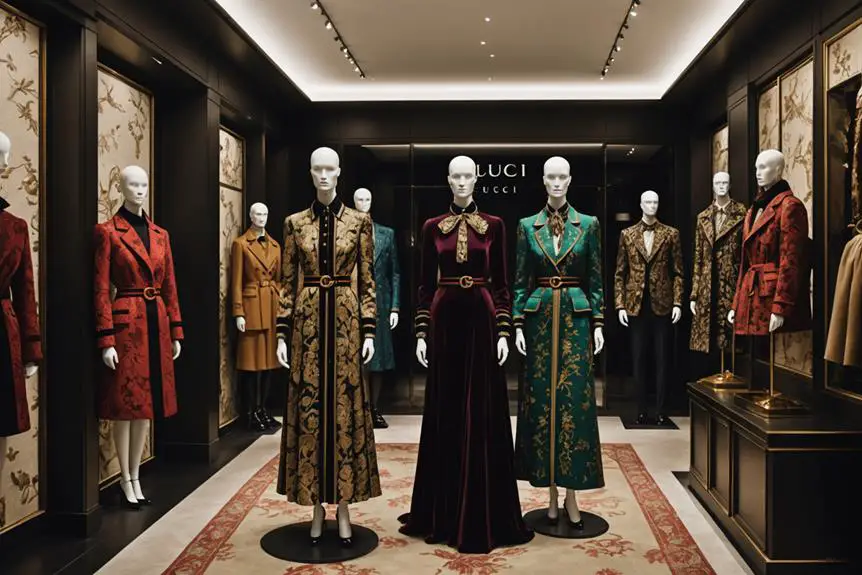So, you're diving into the vintage clothing racket, huh? Here's how to do it like a pro. First, hunt for treasures in thrift stores and flea markets, becoming a regular to snag the best finds. Keep your inventory spot-on with a POS system; it's like having a personal assistant for your stock. Inspect and treat each piece with care, because a little mending goes a long way, and transparency in repairs builds trust. Pricing's an art; make it competitive yet profitable, and always note market trends. Craft an aesthetic so inviting it feels like entering a bygone era. And remember, these are just the opening acts to building your vintage empire.
Source Like a Pro
Let's dive right into the most effective ways to source vintage clothing like a pro. Grab your map or your local guidebook, and let's hit the thrift stores and consignment shops, those quirky, somewhat dusty, but oh-so-exciting places where every rack could hold your next big find.
These are the spots where time seems to pause, giving you a chance to not only shop but to step back in time. Remember, these aren't places to just dash through; they're like treasure hunts. You'll need to visit often, because each time could yield a new gem, maybe a rare '50s dress or an '80s blazer in mint condition. Exploration of multiple stores increases chances of discovery. Acquire knowledge about classic apparel from various resale platforms to enhance your sourcing strategy. Keeping an eye on current pricing trends can also guide your sourcing decisions, especially considering that the resale market is gaining traction due to consumer demand for affordability.
While you're sleuthing around, you've got to play Sherlock – zero in on authenticity and detail, checking each garment as though it's your mission for a vintage Holy Grail. Also, toss regular attention to these shops on your schedule, because habit breeds opportunity. Flea markets often present similar opportunities, with unique finds awaiting at every corner.
Keep your eyes peeled, and inspect with care; quality, not quantity, is your friend. Sure, you might walk out empty-handed occasionally, but when you leave with that one-of-a-kind piece, you'll know that dedicated effort paid off.
Prep for Perfection
Before you let that gem of a vintage shirt slip from your fingertips, make sure it's in tip-top shape. Remember, once you've got your hands on that treasure, you'll want to give it a thorough once-over for any signs of wear or tear, ensuring it sells like hot cakes. A pro tip: Always check for pest infestations, especially in wool items, as those can ruin your entire collection. Plus, you're gonna need to keep track of what's what, so a system for marking down the nitty-gritty details will turn your garage-sale heist into a professional, seamless sale.
Condition Checks
Before selling, learn basic mending, or pass it to a professional because nobody finds moths in their clothes charming – they're just tiny fabric antagonists. Document any repairs like a detective at a crime scene. Every stitch tells a story, and buyers will appreciate the transparency. Stain treatment policies require a careful approach as stains can impact both the wearability and value of vintage garments. Don't horse laugh at the condition; highlight the positives, like history or rarity, alongside flaws, and provide clear descriptions. Buyers will thank you for sharing both the garment's journey and its honesty.
Professional Cleaning Tips
Tackling stains on your vintage clothing? You'll need some insider tricks to bring those pieces back to life.
Here's what you should do:
1. Identify the Stain: Whether it's a drop of oil or a smear of lipstick, knowing what you're dealing with helps. Use a cotton swab dipped in a mild detergent solution for precision cleaning.
Don't forget, some stains might need a bit of gentle coaxing to come out.
2. Choose Your Method Wisely: The fabric dictates the approach. Silk? Go gentle with a protein shampoo. Cotton tees might just love a quick vinegar soak.
Remember, these pieces are survivors from the past, handle them with care.
3. Prep for Perfection: Before you engage, verify the dye hasn't run. Ever watched a ghostly film and seen stains turning water an eerie color?
Yeah, that's drama you don't need. Test a corner; if the color stays, you're good to go.
When dealing with the nuanced beauty of vintage fabrics, every step is a dance of delicate balance.
Record Keeping Systems**
Diving into a well-organized record-keeping system, you'll find yourself juggling inventory, categories, and oh-so-important details, all with ease.
Think of it like setting up your own personal wardrobe but on a grander scale that's a digital symphony.
Begin by selecting a POS system like KORONA POS or Uphance; barcode scanning automates your life by tracking sales in real-time and limiting manual mistakes.
Keep calm with regular audits to check stock levels, ensuring there's no ghost inventory haunting your spreadsheets.
Here's where the magic happens: categorize your treasures into clothing, furniture, or electronics, and don't forget to relegate them into sub-genres.
You'll quickly encounter items that are rare, turning your store into a treasure trove for collectors.
You're painting with numbers and barcodes and organizing everything from Gatsby-esque dresses to '80s one-hit-wonders.
By managing your inventory with precision, you keep your budding secondhand emporium humming smoothly.
Price With Precision
Now, let's talk about how to nail your pricing when selling vintage treasures, shall we? You don't just want to pluck a price out of thin air; you've got to analyze what competitors are doing, and trust me, they're everywhere, from eBay to Etsy, watching each other like hawks.
Plus, remember all those little costs that sneak up on you like that forgotten cake in the back of your fridge – they add up, making your pricing strategy as important as the choice of dress to wear on a date. To accurately assess your earnings, consider using an eBay Fee Calculator to account for all potential fees associated with your sale. Utilizing a dedicated fee calculator can help you determine your potential earnings more accurately.
Understanding fee transparency is crucial for setting competitive prices and ensuring your profits are maximized.
Analyze** Competitor Pricing
5 Key Steps to Analyze Competitor Pricing: Make it a top priority to understand what others are charging for that vintage '80s blazer or those rare Nike sneakers.
Here's what you should do:
1. Understand the Implications of Competitor Pricing: Your goal is to stay competitive, but also to attract customers and hedge your sales strategy.
You're not just selling clothes; you're charting market dynamics like a pro.
2. Data Exploration into Competitors' Listings: Cross over to Etsy, eBay, Depop, Poshmark, Vinted, or thredUp to see the going rate.
Remember, an average price range today mightn't hold tomorrow.
3. Stay Agile: Competitor activities are like trends; they change.
You'll need to be nimble, moving with the market's rhythm.
Matching prices isn't about copying but cleverly blending in to stand out.
- Did That Just Sell?: Keep a close eye on the listings that just sold, especially the one-of-a-kind items or those from iconic high-end brands.
- Adjustment Valve: Fine-tune your prices, staying alert for niche market moves.
As an insider, you're more than just a spectator; you're actively shaping the field.
– Extra Perks: Sometimes, offering an additional discount or 'throwing in something for luck isn't a bad idea; it's your secret to staying competitive.
Account For** All Costs
After understanding competitor pricing to stay competitive and attractive, you'll want to calculate the cost of your items with precision.
Consider the initial product cost, which includes buying the item and any fixes to make it shine. And don't forget the Etsy fees and the work you put into those stunning photos. There's also the shipping, and let's be real, time is money, so factor in your effort to prepare the piece for sale.
For markup, think about how rare or trendy your item is. Some pieces are like gold mines, instantly boosting their worth.
You'll also set a profit margin, usually between 40% to 60%, to make your hustle worth it. Tools and formulas can guide you, but your gut feeling matters too. After all, who knows your collection better than you?
Adjust prices as you learn what flies off the virtual shelf. It's a bit like dating – sometimes it takes a few tries to find the right match, but when you do, it's electric.
And just like a good date, your items need to be priced with care, or they'll keep ghosting you.
Craft a Compelling Catalog
Crafting a compelling catalog starts with identifying high-demand items. You've got to keep your finger on the pulse of what's hot in vintage fashion. Here's how you do that:
- Stay Trendy: Immerse yourself in social media and fashion blogs to catch the wave of current trends.
- Listen Up: Use customer feedback like a compass to guide your stock; what they love, you should sell.
- Data Detective: Use social media insights like a detective would use clues, because numbers don't lie.
Once you've zeroed in on what's in demand, show off those gems:
- Shake Up the Dust: Bring those hidden treasures out of the shadows, showcasing each piece's rare or unique 'X Factor'.
- Weave the Fabric of Time: Spin a yarn about your clothing piece's history, piquing curiosity and potentially hiking up their value.
And finally, remember to give all the juicy details your customers need:
- Spell it Out: From measurements to the backstory, make sure descriptions are as detailed as possible.
- Additionally, incorporating vintage label identification strategies can further enhance your catalog's appeal.
All this needs to feel like chatting with a friend, with just a sprinkle of humor to keep things light and interesting.
This approach won't only make your catalog compelling but will also engage customers.
Style Your Shop
Creating a cozy atmosphere in your shop isn't just about setting the mood, it's like inviting customers into a warm, little corner of the past they can call their own.
Imagine your shop as that quirky aunt's attic where you'd find treasures during rainy weekends; that's the level of charm you're aiming for.
And when it comes to displaying your vintage finds, think like you're curating an exhibit—each piece has a story, and you want even the quietest buyer to feel drawn to that narrative, keen to touch the pages of history draped in front of them.
Cozy Atmosphere
When you design your vintage shop, focus on crafting an ambiance that invites people in. Consider your shop as a cozy retreat where customers can unwind while they browse.
Here's how to get that cozy vibe:
- Warm Lighting: Opt for soft, warm lighting. Envision this: your favorite lamp from home casting a golden glow over a comfy armchair. That's the feel you're going for.
- Calming Colors: Choose colors like soft greens or creamy whites. Imagine your shop walls enveloping customers in a hug. You want them to feel so relaxed they might say, "Let's just take the shop with us!"
- Comfortable Seating: Provide seating with some charm. Think of those plush velvet armchairs or an attractively worn wooden bench you've admired.
It's not just about comfort but also about creating those Instagrammable moments that keep customers coming back for the experience.
Vintage Display Techniques**
Enhance your shop's allure with these vintage display techniques. Start with freestanding gold racks; not only do they add a touch of elegance, think of them as little stages for your vintage treasures.
Wall shelves aren't just space-savers; they're like the anthems of lesser-known bands, waiting to be uncovered.
And let's not forget those whimsically shaped clothing racks—each one tells a story, like a suitcase full of memories inviting customers to imagine their past.
To really make your space work for you, stretch upwards like your favorite ivy, using scarf display racks in corners or even spiraling towards the ceiling. It's like staging your own little fashion show.
When you enrich your displays with vintage ladders, it's like you're inviting customers to climb into a cozy, nostalgic nook.
But, keep it playful with mannequins, dressing them up like old friends ready for a night out, always switching up their looks to keep things fresh.
Finally, wall pegs and bars add that personal touch, transforming each corner of your shop into an art gallery. 🎨
Master Visual Merchandising
Mastering visual merchandising is key to selling vintage clothing due to the highly visual appeal of these items. To really create a memorable shopping experience:
- Display Strategy is Essential:
- *Group items* by like materials, colors, or textures. See that wool sweater? If it's paired with velvet or tweed, it pops out on the rack, creating an irresistible allure.
- *Backdrop colors* can be your quiet hero. A coral top against a plum wall? Suddenly, 1970s jumps to 2023.
- *White space* lets each piece breathe, spotlighting the ones that deserve the customer's gaze.
- *Rotate* your displays to keep regulars intrigued; think of new arrivals as tiny invitations to explore anew each time.
- Make It Interactive:
- Employ mannequins and *sales staff* in theme attire; it's like giving your vintage threads a modern stage.
- Checkout Transformation:
- *Focus on drama*—your checkout isn't just where you pay; transform it into an event. Hang that shimmery flapper dress, and watch wallets open as the cash register dances.
Implement Inventory Management
Managing your visual merchandising effectively showcases your vintage clothing, and now it's time to turn your attention to how you manage what isn't on display — your inventory. A well-thought-out inventory system doesn't just keep your stock levels honest; it's like having a backstage that guarantees the show runs smoothly.
You'll want to plunge into POS-based inventory software. Something like KORONA POS isn't just a system; it's a silent helper, allowing you to track products in real time and generate daily sales reports, so you're always in the loop. Set up your inventory by grouping items into well-thought-out categories; we're talking clothes, furniture, or the electronics you thought were '80s made it to the shelves.
Shelving your inventory smartly means you'll rotate stock like a pro, assuring high-demand items are always around for enthusiastic hands while keeping slow movers at the back, ready for a quiet exit.
And remember, every now and then, treat your store to a full-on physical count. It's like the wardrobe clean-out but for business. It keeps your numbers straight or as straight as a '70s tie-dye.
Keep tabs on what sells and what doesn't, and adjust your stock accordingly because managing inventory, like any good relationship, needs regular care and attention to flourish.
Build Customer Loyalty
Building customer loyalty is key to keeping your vintage clothing store at the top of your customers' minds. Imagine this: You've gone out of your way to snag that rare '80s jacket, and now you want to guarantee your customer remembers you when they outfit their next decade's-themed party.
Here's what you can do:
- Create Engaging Social Media Content:
- Use Visual Posts: Share eye-catching images or videos to grab attention. A video of the '80s jacket, twirling to flaunt its glory, could make your customers feel like they can't live without it.
- Customer Showcase: "Did Alice wear that jacket better than the original owner? You decide. Let your customers star on your stage, and watch your brand's loyalty soar.
Establish a loyalty program, like earning points for purchases or social shares – think "every scarf retweeted, a chance to claim a free scarf!" Reward customer referrals with unique offers, and keep members always ahead of the curve with exclusive access like sneak peeks of your new stock.
It's about making customers feel valued, turning occasional shoppers into ardent enthusiasts.
Navigate Shipping Solutions
When you've built a base of loyal customers who keep coming back for your unique vintage finds, you'll want to guarantee their experience remains positive from purchase to delivery.
First off, let's talk about choosing the right carrier. Save a pretty penny by snagging volume-based discounts from carriers like Chit Chats, utilizing services such as Canada Post or USPS. You want fuss-free pickups or provisions at nearby drop-offs, right? The e-commerce platforms, like Shopify or Etsy, have generally sorted out the best carrier deals for you.
Explore regional couriers for domestic orders; they're often kinder on your wallet, with fun options like Royal Mail for UK customers.
Now, imagine this charming experience for your clients: unwrapping their package, filled with delightful vintage wear, securely nestled in eco-friendly, reused packaging. We're talking biodegradable mailbags, custom boxes, and you, behind the scenes, snapping quick pictures of your buzzy shop.
Tracking should be as exciting, with free updates to keep your customers all jazzed up for what's headed their way. By picking the right carrier, you confirm that these treasures reach their new homes safely.
Plan Sales Strategies
Ever wonder how to make your vintage clothing irresistibly priced? Let's plunge into!
– Start by setting Competitive Prices. You'll want to price your items so your customers feel they're getting a steal. Here's how:
- Research Competitors: Hop online and see what similar items sell for, considering the condition, brand, and uniqueness. This gives you a market benchmark.
- Monitor Market Trends: Keep your ear to the ground regarding current fashion trends, customer feedback, and seasonal demands. Adjust your pricing to stay one step ahead.
- Use Pricing Formulas: Apply a formula considering your costs, trends, and the item's desirability. Don't just go with gut feeling alone.





Great read! I found some useful takeaways that I’ll definitely apply. Thanks for sharing.
Really insightful post! I appreciate the clarity and depth you provided here.
Great read! I found some useful takeaways that I’ll definitely apply. Thanks for sharing.